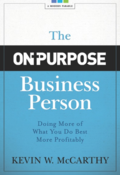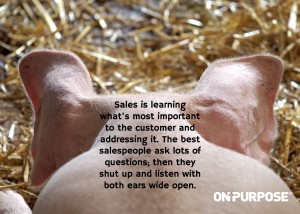“The compelling why” is not the same as your “why” — your true reason for being.
The concept of a compelling why is really just an important mission that captures our heart and spurs us on with unfolding energy, vigor, and determination. But missions eventually end. At that point, does it mean our reason for being ends too? Of course not!

Getting on the bandwagon for a good cause is worthy.
But what if there’s more to life than a compelling why?
In today’s On-Purpose Minute, consider the importance of knowing your simple why and the profound manner in which it can inform your life, keep you from costly distractions or dangerous detours, and help you make much better decisions across the board.
Your why can be thought of as the pilot flame. A meaningful cause or a “compelling why” brings added fuel and focus to a fire already burning within you.
Think of your simple why as your purpose in life.
Purpose answers the big question, Why do I exist? When you know the answer to this question, everything else in life has context and meaning. This is a powerful and healthier place to be in your life and decision-making.
At On-Purpose Partners, we help clients write their why in 2-word purpose statements. From decades of experience we know that when this core question is answered short and sweet, life and business improves—period.
A “compelling why” is often batted about by motivational speakers, sales trainers, and leaders to engage people in their cause or vision of the future.
Getting swept up in the moment or the movement regardless of whether it is a charitable cause, a sports team, or a political candidate is exciting and worthwhile. Most of us are drawn to a compelling why and jump on board because it is a good fit or it aligns with our purpose.
Examples of a “compelling why”—really a meaningful mission—are below:
- A single mom working two jobs to provide a college education for her children
- Mothers who from their loss of a loved one start MADD (Mothers Against Drunk Driving) to educate and advocate against drunk driving and drivers
- Volunteers who work to stop human trafficking, hunger, oppression, or other social needs
Worthy causes touch each person’s soul differently. Have you ever considered why one cause is meaningful and engaging to you … while others are not, yet someone else is on fire and passionate about the same cause? Personal experience and preference certainly play into the attraction, but there’s more below the surface.
Your why lives below the surface.
This is the On-Purpose Principle at work where the purpose of the person and the purpose of the organization have high alignment. Therefore, you’re more inclined to be engaged or compelled to participate with the preciousness of your time, talent, and resources.
Would you like help in discovering your 2-word Personal Purpose Statement?
Go to ONPURPOSE.me.  This online app will guide you through a process of selecting a purpose statement, plus you’ll receive a 10-email course that’s practical to being on-purpose.
This online app will guide you through a process of selecting a purpose statement, plus you’ll receive a 10-email course that’s practical to being on-purpose.

 After decades of advising thousands of business owners, the patterns of poverty jump at me. If you are a business owner, sales manager, or a salesperson, then pay close attention to this message. Benchmark yourself against my comments and see how well your selling system operates to support your field. Perhaps there’s a reason why you can’t find and keep good salespeople!
After decades of advising thousands of business owners, the patterns of poverty jump at me. If you are a business owner, sales manager, or a salesperson, then pay close attention to this message. Benchmark yourself against my comments and see how well your selling system operates to support your field. Perhaps there’s a reason why you can’t find and keep good salespeople!

